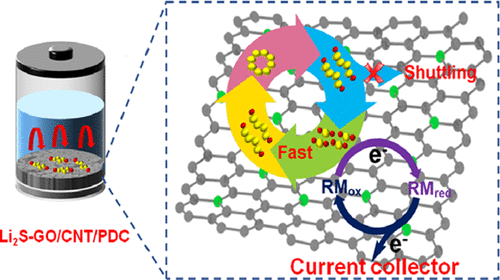当前位置:
X-MOL 学术
›
ACS Sustain. Chem. Eng.
›
论文详情
Our official English website, www.x-mol.net, welcomes your
feedback! (Note: you will need to create a separate account there.)
Polyaniline-Derived Carbon Heterostructure as Redox Mediator of Li2S Oxidation and Polysulfide Immobilizer for High-Performance Lithium–Sulfur Cathode
ACS Sustainable Chemistry & Engineering ( IF 7.1 ) Pub Date : 2020-10-23 , DOI: 10.1021/acssuschemeng.0c06310 Hong Liu 1 , Peng Zeng 1 , Yongfang Li 1 , Hao Yu 1 , Manfang Chen 1 , Sidra Jamil 1 , Changqing Miao 2 , Gairong Chen 2 , Qi-Cheng Liu 3 , Zhigao Luo 1 , Xianyou Wang 1
ACS Sustainable Chemistry & Engineering ( IF 7.1 ) Pub Date : 2020-10-23 , DOI: 10.1021/acssuschemeng.0c06310 Hong Liu 1 , Peng Zeng 1 , Yongfang Li 1 , Hao Yu 1 , Manfang Chen 1 , Sidra Jamil 1 , Changqing Miao 2 , Gairong Chen 2 , Qi-Cheng Liu 3 , Zhigao Luo 1 , Xianyou Wang 1
Affiliation

|
The merit of high energy density endows the lithium sulfide (Li2S)-based lithium–sulfur batteries (LSBs) as a promising candidate for next-generation energy storage batteries. In this work, Li2S is chemically anchored onto the surface of two-dimensional graphene oxide (GO), which is then tangled and connected by one-dimensional carbon nanotube (CNT) to promote electron transfer, and finally further embedded with PANI-derived carbon (PDC) to suppress a polysulfide shuttle. The deliberately designed carbon matrix offers a fast electron and ion transfer route, suitable surface area, void volume, and pore size for redox reactions and polysulfide confinement. Furthermore, PDC could synergistically immobilize polysulfides inside the cathode by means of chemisorption so as to restrain the shuttle effect in LSBs. Last but not least, PDC with a quinone-based structure could function as a redox mediator (RM) to facilitate Li2S oxidation with minimized polarization. Benefited from the aforementioned advantages, the as-fabricated Li2S-GO/CNT/PDC composite, which is coupled with a lithium metal as the anode, delivers initially a high specific capacity of 925 mAh g–1 at 0.1 C and good retention capability of 550 mAh g–1 after 400 cycles at 2 C. Therefore, the good electrochemical behavior of the Li2S-GO/CNT/PDC composite suggests its promising prospects for the commercial application of LSBs in high-energy storage devices.
中文翻译:

聚苯胺衍生的碳异质结构作为Li 2 S氧化和聚硫化物固定剂的氧化还原介体,用于高性能锂硫阴极
高能量密度的优点使基于硫化锂(Li 2 S)的锂硫电池(LSBs)成为下一代储能电池的有希望的候选者。在这项工作中,李2S化学固定在二维氧化石墨烯(GO)的表面上,然后通过一维碳纳米管(CNT)缠结并连接以促进电子转移,最后进一步嵌入PANI衍生的碳(PDC)抑制多硫化物穿梭。精心设计的碳基质可提供快速的电子和离子转移途径,合适的表面积,空隙体积和孔径,以用于氧化还原反应和多硫化物限制。此外,PDC可以通过化学吸附作用将多硫化物协同固定在阴极内部,从而抑制LSB中的穿梭效应。最后但并非最不重要的是,具有基于醌的结构的PDC可以充当氧化还原介体(RM)来促进Li 2具有最小极化的S氧化。得益于上述优势,已制成的Li 2 S-GO / CNT / PDC复合材料与锂金属作为阳极结合,最初在0.1 C时可提供925 mAh g –1的高比容量,并具有良好的保持力在2 C下经过400次循环后,其容量为550 mAh g –1。因此,Li 2 S-GO / CNT / PDC复合材料的良好电化学行为表明LSB在高能量存储设备中的商业应用前景广阔。
更新日期:2020-11-09
中文翻译:

聚苯胺衍生的碳异质结构作为Li 2 S氧化和聚硫化物固定剂的氧化还原介体,用于高性能锂硫阴极
高能量密度的优点使基于硫化锂(Li 2 S)的锂硫电池(LSBs)成为下一代储能电池的有希望的候选者。在这项工作中,李2S化学固定在二维氧化石墨烯(GO)的表面上,然后通过一维碳纳米管(CNT)缠结并连接以促进电子转移,最后进一步嵌入PANI衍生的碳(PDC)抑制多硫化物穿梭。精心设计的碳基质可提供快速的电子和离子转移途径,合适的表面积,空隙体积和孔径,以用于氧化还原反应和多硫化物限制。此外,PDC可以通过化学吸附作用将多硫化物协同固定在阴极内部,从而抑制LSB中的穿梭效应。最后但并非最不重要的是,具有基于醌的结构的PDC可以充当氧化还原介体(RM)来促进Li 2具有最小极化的S氧化。得益于上述优势,已制成的Li 2 S-GO / CNT / PDC复合材料与锂金属作为阳极结合,最初在0.1 C时可提供925 mAh g –1的高比容量,并具有良好的保持力在2 C下经过400次循环后,其容量为550 mAh g –1。因此,Li 2 S-GO / CNT / PDC复合材料的良好电化学行为表明LSB在高能量存储设备中的商业应用前景广阔。











































 京公网安备 11010802027423号
京公网安备 11010802027423号